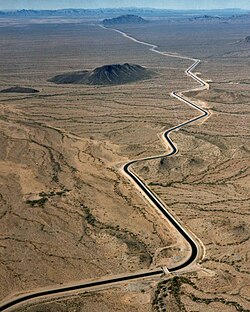History of Arizona
Template:Topical guide (historical) The history of Arizona as recorded by Europeans began in 1539 with the first documented exploration of the area by Franciscan Marcos de Niza, early work expanded the following year when Francisco Vásquez de Coronado entered the area as well. Arizona was part of Vieja California from 1822. In 1848, the United States took possession of most of it after the [Mexican-American War]]. The Gadsden Purchase secured more in 1853. on February 24, 1863, Arizona was split off from the Territory of New Mexico into its own entity, before becoming a U.S. state on February 14, 1912.
Mexican Arizona

In 1836, Texas declared independence from Mexico and claimed much of the territory in the northern lands of Mexico. When the United States annexed Texas in 1846 over the strong objections of the Mexican government, U.S. troops moved into disputed territory. Despite offers to buy the disputed lands from Mexico, hostilities erupted in what is known as the Mexican-American War (1846–1848). The U.S. occupied Mexico City and forced the newly founded Mexican Republic to give up its northern half, including the later Arizona.
In the Treaty of Guadalupe Hidalgo (1848), Mexico ceded to the U.S., together with many more territories, approximately the northern 70% of what is today Arizona, while this treaty also specified that the U.S. pay Mexico the sum of US$15 million in compensation.[citation needed] In 1849, the California Gold Rush led as many as 50,000 miners through the region, leading to major booms in Arizona's population. In 1850, the aforementioned 70% of Arizona, together with most of present day New Mexico, was organized as the New Mexico Territory. In 1853, President Franklin Pierce sent James Gadsden to Mexico City to negotiate with Santa Anna, and the United States bought the remaining area of Arizona and New Mexico in the Gadsden Purchase.
American Arizona

Starting in 1853, the entirety of present-day Arizona was part of the New Mexico Territory. During the Civil War, on March 16, 1861, southern New Mexico Territory around Mesilla (now in New Mexico) and Tucson declared itself independent from the United States to join the Confederacy. Confederate Territory of Arizona (CSA) was regarded as a valuable route for possible access to the Pacific Ocean, with the specific intention of joining southern California to the Confederacy. [In 1860, Southern California had cleared all legal hurdles for secession from the rest of California and was waiting reorganization as a new U.S. territory, which never materialized. At that time, sparsely populated Southern California was a hotbed of Southern sympathizers.]
In March 1862, Union troops re-captured the Confederate Territory of Arizona and returned it to the New Mexico Territory.
The Battle of Picacho Pass, April 15, 1862, was a battle of the Civil War fought in the CSA and one of many battles to occur in Arizona during the war. Between three sides, Apaches, Confederates and Union forces. In 1863, the U.S. split up their New Mexico Territory along a north-south border to create the U.S. Arizona Territory, which was later to become the state of Arizona.

Statehood
In the 20th century, Arizona almost entered the Union as part of New Mexico in a Republican plan to keep control of the U.S. Senate. The plan, while accepted by most in New Mexico, was rejected by most Arizonans. Progressives in Arizona favored inclusion in the state constitution of initiative, referendum, recall, direct election of senators, woman suffrage, and other reforms. Most of these proposals were included in the constitution that was submitted to Congress in 1912. President William Howard Taft insisted on removing the recall provision (because it would allow recall of judges) before he would approve it. It was removed, Taft signed the statehood bill on February 14, 1912, and state residents promptly put the provision back in.[1]
In 1912 women gained suffrage (the vote) in the state, eight years before the country as a whole.
The Great Depression and the World Wars

After the Great Depression, World War II revitalized the Arizona economy.
Recent events

Super Bowl XXX was played in Tempe in 1996 and Super Bowl XLII was held in Glendale in 2008.
Illegal immigration continued to be a prime concern within the state, and in April 2010, Arizona SB1070 was passed and signed into law by Governor Jan Brewer.[2] The measure attracted national attention as the most thorough anti-illegal immigration measure in decades within the United States.[2]
See also
- Spanish Arizona
- Estevanico
- Fort Date Creek
- Republic of Sonora
- Territorial evolution of Arizona
- James Reavis, The 'Baron of Arizona'
Notes
- ^ Cindy Hayostek, "Douglas Delegates to the 1910 Constitutional Convention and Arizona's Progressive Heritage," Journal of Arizona History 2006 47(4): 347-366
- ^ a b Archibold, Randal C. (April 24, 2010). "U.S.'s Toughest Immigration Law Is Signed in Arizona". The New York Times. p. 1.
Bibliography
- Cheek, Lawrence W. (1995). Arizona. Oakland, CA: Compass American Guides. ISBN 1-878867-72-5
- Johnson, G. Wesley Jr. (1993). Phoenix in the Twentieth Century: Essays in Community History. Univ. of Oklahoma Press. ISBN 0806124687.
- Johnson, G. Wesley, Jr. Phoenix, Valley of the Sun (1982), popular
- Luckingham, Bradford. Phoenix: The History of a Southwestern Metropolis (1995)
- Sheridan, Thomas E. Arizona: A History (1995) excerpt and text search
- VanderMeer, Philip. Desert Visions and the Making of Phoenix, 1860-2009 (2010) ISBN 978-0-8263-4891-3, scholarly
- VanderMeer, Philip. Phoenix Rising: The Making of a Desert Metropolis (2002), popular
- Walker, Henry Pickering (1986). Historical atlas of Arizona (2nd ed. ed.). Norman: University of Oklahoma press. ISBN 080612024X.
{{cite book}}:|edition=has extra text (help); Unknown parameter|coauthors=ignored (|author=suggested) (help)
